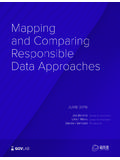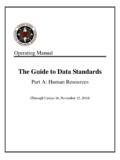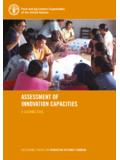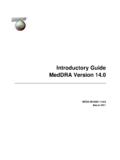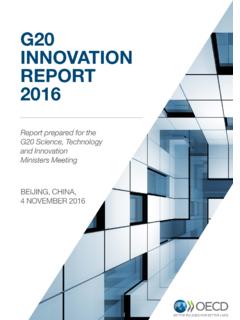Transcription of A GUIDE TO - United Nations Global Pulse
1 1A GUIDE TODATA innovation FOR DEVELOPMENTFROM IDEA TO PROOF-OF-CONCEPTV ersion 1, December 201623 Any development practitioner interested in data innovation can benefit from this GUIDE . You do not need expertise in data science to integrate data into your projects! If you are a forward-looking innovator excited about improving your work and the work of your institution and partners, this GUIDE can help. WHAT IS data innovation ? data innovation is the use of new or non-traditional data sources and methods to gain a more nuanced understanding of development challenges. data innovation often combines non-traditional with traditional sources of data , such as household surveys, to reframe issues and shed new light on seemingly intractable problems.
2 New, or non-traditional data sources may include digital data derived from social media, web content, transaction data , GPS devices (see pp 19 for more). Because combining data sources can provide more complete, more timely, and/or more granular information about an issue, data innovation can open opportunities for more cost- effective interventions, as well as provide entirely new insights that may have been overlooked through traditional approaches. WHY DO development PRACTITIONERS NEED data innovation ? Governments and development agencies around the world are increasingly moving away from old models of problem-solving, and searching for new, more networked models of resilience.
3 data innovation is a vital element of this effort. Identifying and integrating faster, more detailed insights into development programme planning processes can lead to better-targeted responses and more efficient resource allocation. data innovation is also part of reaching the Sustainable development Goals (SDGs). Effective data collection, analysis, and monitoring can help policymakers to course-correct programmes and policies more quickly, leading to cost efficiencies and greater returns on investments, as well as empower communities ultimately helping to achieve the goals. HOW CAN THIS GUIDE HELP? This GUIDE will provide practical guidance in designing a data innovation project, as well as tools for recruiting allies both within and outside of your organization.
4 It does not include specifics about data analysis; you ll collaborate with a data Expert for those. Instead, this GUIDE offers an understanding of the scope and scale of data innovation projects, and guidance on asking the right questions from the GUIDE covers the project design phase from the earliest hint of a data innovation idea through the creation of a proof-of-concept. This project design phase may take as long as the actual solution development process itself, because it requires thoughtful coordination among various stakeholders. But with this groundwork firmly in place, data innovation has a better chance of success. CASE STUDY: Improving late-night transportation through data innovation Low-income workers in Seoul needed a new transportation option for commuting late at night.
5 There was no night bus service, and taxis were expensive and hard to find. To establish a new night bus route, city officials analysed aggregated and anonymized mobile phone usage patterns to understand the most common points of departure and destination for travelers. This insight allowed officials to efficiently create a targeted Owl Bus route map, which best served late-night travelers. For more information: don t have to be a data scientist to innovate with data . 5 ABOUT THIS PUBLICATION Recognizing the potential of data innovation , the United Nations development Programme (UNDP) innovation teams at the Regional Centre for Europe and the Commonwealth of Independent States (ECIS) and the Regional Hub for Arab States embarked on a big data for development exploration journey, seeking to harness new sources of data to improve services or programme implementation on topics including disaster risk management, improved welfare, migration, and poverty reduction.
6 As part of this exercise, six UNDP Offices from the two regions developed data innovation proof-of-concept projects with governmental and civil society partners, to address urgent local challenges and gain hands-on experience in data Global Pulse provided technical guidance, coaching and tools to the project managers for the duration of the exercise, and the cohort shared advice and challenges at in-person workshops. This GUIDE is based on these experiences, and on the methodology created by Global Pulse to design and implement data innovation projects across the UN system. The joint exercise showed how alternative sources of data can and should play a role in pursuing development outcomes and, as such, hold great promise for fulfilling the Sustainable development Goals both from the perspective of pursuing the outcomes as well as enabling (close to) real-time monitoring and evaluation.
7 This publication is a how-to resource for UNDP staff around the world, and is designed to help further data innovation efforts within the UN and throughout the development field. ABOUT THE United Nations development PROGRAMME (UNDP)UNDP is the UN s Global development network, advocating for change and connecting countries to knowledge, experience, and resources to help people build a better life. UNDP is on the ground in 177 countries and territories, supporting their own solutions to development challenges and developing national and local capacities that will help them achieve human development and the Sustainable development more online at UN Global PULSEG lobal Pulse is an innovation initiative of the United Nations Secretary-General.
8 Global Pulse is working to promote awareness of the opportunities big data presents for sustainable development and humanitarian action, forge public-private data sharing partnerships, generate high-impact analytical tools and approaches through its network of Pulse Labs, and drive broad adoption of useful innovations across the UN more at: TO READ THIS GUIDEThis practical GUIDE will help you lay the groundwork for integrating data innovation into your projects. If you re working on your first data innovation project, we suggest you go through the GUIDE chronologically to make sure you remember each step and keep your project on sure to meet the requirements of Checkpoint A before progressing to Sections Two and you have previous experience managing data innovation projects, our suggestion is that you will refer back as you progress on your journey, dipping in and out of specific modules as they become relevant to your work.
9 67 Understand who will use your data innovation resultsSECTION ONET able of ContentsExplore the Problem & SystemAssemble the TeamSECTION TWOD efine the problem you re trying to 1 .. p. 9 Account for Five Key Responsibility AreasMODULE 1 .. p. 26 Secure support from data Holder(s)MODULE 2 .. p. 30 Find your data ExpertMODULE 3 .. p. 32 Inventory and understand the data 2 .. p. 11 Map all stakeholdersMODULE 3 .. p. 13 Identify your data wish list and define your hypothesisMODULE 5 .. p. 18 CHECKPOINT A ( ): O cial permissionDevelop a concept noteMODULE 1 .. p. 36 Ensure data protection and privacyMODULE 2 .. p. 38 Plan how to measure and share your resultsFull library of tools for useMODULE 3.
10 P. 41 Create the Work PlanSECTION THREEMODULE 4 .. p. 15 CHECKPOINT B (p. 45): Create a Proof-Of-ConceptUnderstand who will use your data innovation resultsANNEX .. p. 48 Problem Definition Tool .. p. 10 data Gaps Tool .. p. 12 Stakeholder Mapping Tool .. p. 14 data Journey Tool .. p. 17 Project Concepting Tool .. Annex89 SECTION 1: EXPLORE THE PROBLEM & SYSTEME very successful data innovation project starts with a well-defined problem (such as a development challenge or a policy issue) as well as a deep understanding of the institutional system around the problem. With many fascinating data sources available, innovators in both the public and private sectors often get carried away collecting or diving into data sources that don t really matter to the actual challenges they face.


